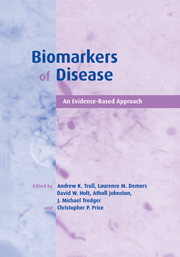16 results
Preface
-
- Book:
- Biomarkers of Disease
- Published online:
- 20 August 2009
- Print publication:
- 06 June 2002, pp xxi-xxii
-
- Chapter
- Export citation
Part 9 - Biomarkers in transplantation
-
- Book:
- Biomarkers of Disease
- Published online:
- 20 August 2009
- Print publication:
- 06 June 2002, pp 413-414
-
- Chapter
- Export citation
45 - The use of biomarkers for monitoring the response to immunosuppressive drug therapy
-
-
- Book:
- Biomarkers of Disease
- Published online:
- 20 August 2009
- Print publication:
- 06 June 2002, pp 451-460
-
- Chapter
- Export citation
Part 4 - Biomarkers of liver disease and dysfunction
-
- Book:
- Biomarkers of Disease
- Published online:
- 20 August 2009
- Print publication:
- 06 June 2002, pp 165-166
-
- Chapter
- Export citation

Biomarkers of Disease
- An Evidence-Based Approach
-
- Published online:
- 20 August 2009
- Print publication:
- 06 June 2002
Frontmatter
-
- Book:
- Biomarkers of Disease
- Published online:
- 20 August 2009
- Print publication:
- 06 June 2002, pp i-iv
-
- Chapter
- Export citation
Part 6 - Biomarkers in toxicology
-
- Book:
- Biomarkers of Disease
- Published online:
- 20 August 2009
- Print publication:
- 06 June 2002, pp 289-290
-
- Chapter
- Export citation
Index
-
- Book:
- Biomarkers of Disease
- Published online:
- 20 August 2009
- Print publication:
- 06 June 2002, pp 483-494
-
- Chapter
- Export citation
Part 2 - Biomarkers of kidney disease and dysfunction
-
- Book:
- Biomarkers of Disease
- Published online:
- 20 August 2009
- Print publication:
- 06 June 2002, pp 43-44
-
- Chapter
- Export citation
Part 5 - Biomarkers of gastrointestinal disease and dysfunction
-
- Book:
- Biomarkers of Disease
- Published online:
- 20 August 2009
- Print publication:
- 06 June 2002, pp 263-264
-
- Chapter
- Export citation
Part 7 - Biomarkers of cardiovascular disease and dysfunction
-
- Book:
- Biomarkers of Disease
- Published online:
- 20 August 2009
- Print publication:
- 06 June 2002, pp 323-324
-
- Chapter
- Export citation
Part 3 - Biomarkers of bone disease and dysfunction
-
- Book:
- Biomarkers of Disease
- Published online:
- 20 August 2009
- Print publication:
- 06 June 2002, pp 97-98
-
- Chapter
- Export citation
List of contributors
-
- Book:
- Biomarkers of Disease
- Published online:
- 20 August 2009
- Print publication:
- 06 June 2002, pp x-xx
-
- Chapter
- Export citation
Part 8 - Biomarkers of neurological disease and dysfunction
-
- Book:
- Biomarkers of Disease
- Published online:
- 20 August 2009
- Print publication:
- 06 June 2002, pp 389-390
-
- Chapter
- Export citation
Part 1 - Assessing and utilizing the diagnostic or prognostic power of biomarkers
-
- Book:
- Biomarkers of Disease
- Published online:
- 20 August 2009
- Print publication:
- 06 June 2002, pp 1-2
-
- Chapter
- Export citation
Contents
-
- Book:
- Biomarkers of Disease
- Published online:
- 20 August 2009
- Print publication:
- 06 June 2002, pp v-ix
-
- Chapter
- Export citation



